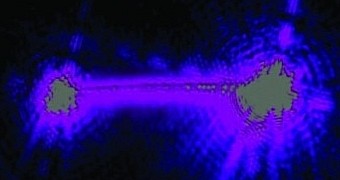Optical connectivity technology is the fastest way available to send data across a network and the Internet, but we'll have to move on eventually. And what better way to improve things, than with lasers?
Lasers can transmit information by producing pulses. Essentially, the way they turn on and off can be translated into 1s and 0s, the two building blocks of binary language on which all information technology relies.
The fastest lasers currently known to man need a few nanoseconds to complete one cycle of activation and deactivation. Turning on and off really fast.
The new one that we're about to talk about only needs less than a picosecond to complete such an operation.
The ultra-fast nano-laser
In layman’s terms, the previous statement means that the laser can turn on and off one trillion times in one second, making it a thousand times faster than the fastest lasers currently available.
The laser can pulse so quickly, in fact, that the scientists who invented it had to develop a new optical switching method just to measure the speed.
It was a fairly involved task for the physicists from Imperial College London in the UK and the Friedrich Schiller University Jena in Germany, but it paid off, since the new laser set a huge record.
How the feat was achieved
Lasers are usually made of nanowires placed on a glass surface, but the researchers decided to use a silver surface instead. As they explained it, they “sped up” the light by “squeezing” it.
Silver has something called surface plasmons, wave-like motions of excited electrons that can squeeze light into a much smaller space inside the laser. That means the light interacted more strongly with the nanowires that actually emitted the light themselves.
Speaking of which, the scientists employed zinc wire nanowires with a diameter of only 120 nanometers, a thousands of a human hair in layman’s terms. They are already quite good at pulsing light, but the use of silver improved their capacity. In the end, the laser is supposed to be the fastest possible while still using semiconductors.
Uses beyond the web
The best part is that the laser is stable at room temperature, otherwise it wouldn't have been usable in Internet and other communication systems. It will be interesting to watch what comes of this new invention.
The only possible problem is that silver isn't exactly as abundant as glass, or as cheap, and there doesn't seem to be a way to substitute it for a more affordable material.

 14 DAY TRIAL //
14 DAY TRIAL //